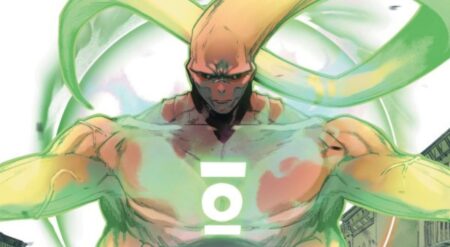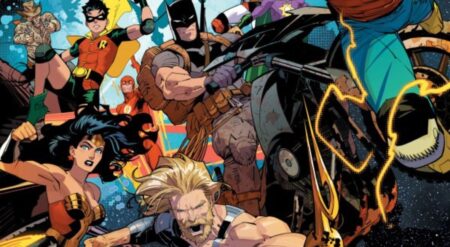
Wonder Woman #750 is DC Comics’ all-star 96-page celebration of the Amazon Princess who became an icon for comic fans throughout the world. An oversized wonder, this issue tells tales from Diana’s past and present, along with some major implications for the future of DC’s first female superhero. Wonder Woman #750 consists of nine stories, with contributors that include Colleen Doran, Mariko Tamaki, and legendary Wonder Woman creators Gail Simone, Liam Sharp, Nicola Scott, and Greg Rucka.
Readers love Wonder Woman for so many reasons. Some fans love her empathy, others, like me, love her for her ferocity. Wonder Woman #750 captures the diversity of her strength and the multitude of reasons as to why we love her and enjoy her stories. This ultimately means that there is a story for everyone in this huge issue.
Wonder Woman #750 opens up with “The Wild Hunt Finale,” written by Steve Orlando, with pencils by Jesus Merino, inks by Vincente Cifuentes, colors by Romulo Fajardo Jr., and letters by Pat Brosseau. The two best parts of this story are the opening and Orlando’s dialogue. I’ve been through a lot so hearing Diana declare how much she’s lost, and how even at her lowest seeing her find the strength to care hit me hard. It wasn’t about finding the strength to win, just to care. It’s a small note but it means so much. Oranldo’s dialogue highlights Diana’s ability to not quit and the process behind it. Additionally, Merino and Cifuentes’ art is gorgeous, with Diana as a buff fighter and not looking rail-thin like she has been depicted in the past – and in this issue in many of the other stories.
Next up is “From Small Things, Mama.” Written by Gail Simone, with pencils and inks by Colleen Doran, colors by Hi-Fi, and letters by Dave Sharpe, which is a place for this issue to revisit Diana’s love and compassion and even give fans the return of Star-Blossom. In this story, we see Diana’s softness, not her fighting. She’s mentoring Star-Blossom and also grappling with the thought of not being untouchable which showcases how the two can learn from each other. It’s a cute story that will hit with a younger audience extremely well.
The third story is “The Interrogation,” written by Mariko Tamaki, with pencils and inks by Elena Casagrande, colors by Sunny Gho, and letters by Deron Bennett. This story shows Wonder Woman’s strength and is my favorite of the issue. From the art (which features one of my now-favorite Wonder Woman panels of all time at the top of page-44) to the concept, every piece of this story sings a powerful song. “What’s the difference between a hero and the person who NEEDS to be a hero,” is a question that has been asked throughout comics, but the answer that Tamaki gives here captures the core of Diana and of Wonder Woman.
Meanwhile, “Never Change,” written by Greg Rucka, with pencils and inks by Nicola Scott, with colors by Farjado Jr., and letters by Rob Leigh, tests Diana’s friendship and grace. The artwork is unique, standing out against the other ways that artists have chosen to stylize Diana, and the story, while not groundbreaking is a loving friendship that is also a large piece of her character. Next is “To Leave Paradise…” written by Kami Garcia, with pencils by Phil Hester, inks by Ande Parks, colors by Trish Mulvhill, and letters by Gabriela Downie. This story features a young Diana. Instead of her powers, this story focuses on who her growth on Themascyra and even features Nubia as a mentor and friend.
In “Emergancy Visit,” written by Shannon Hale and Dean Hale, with pencils and inks by Riley Rossmo, colors by Ivan Plascencia, and letters by Joshua Reed, we see Diana and her family. In this story we see familial ties and friendship put first when the Amazons call for Diana to come home. The art this issue is sure to get people talking, and I for one love it. Diana is imposing, tall, and the hyper-stylized illustrations work to break up some of the monotony this issue. Which by and large make Diana extremely thin, almost petite, and always delicate even when telling a story of her strength, this is replicated in the variant covers as well.
“To Me,” is written by Marguerite Bennett, with pencils and inks by Laura Braga, colors by Farjado Jr., and Wes Abbott on letters. It brings reader to the pin-up Bombshell aesthetic and works extremely well. But this story is also one of the top ones of the issue, not showing us Diana as we see her, but showing us Diana as those she interacts with sees her.
Next is “Always,” written by Vita Ayala, with Amancay Nahuelpan on pencils and inks, with colors by Jar David Ramos, and letters by Clayton Cowles. This story highlights Diana’s immense capability of empathy. When Silver Swan, a woman she saved attacks her, Diana works to free her. Not to fight her, but to protect her, to talk her down, and not to defeat her. This issue is beautifully written. Ayala’s words are heartfelt and moving while the art from Nahuelpan is fierce while in battle and soft while embracing. It’s another standout story in Wonder Woman #750.
And finally, “A Brave New World” is written by Scott Snyder, with pencils and inks by Bryan Hitch, colors by Mike Spicer, and letters by Tom Napolitano. In this story, we see Diana in the past as Snyder writes a narration of Wonder Woman’s story, of her impact on the world. This final story isn’t just speaking to the world of the comics, it’s speaking to us.
This issue also provides fans with eight variant covers that tracks Wonder Woman’s identity over the 80 decades she’s been published in with one from the 1940s by Joshua Middleton, the 1950s by Jenny Frison, the 1960s by J. Scott Campbell and Sabine Rich, the 1970s by Olivier Coipel, the 1980s by George Pérez and Laura Martin, the 1990s by Brian Bolland, the 2000s by Adam Hughes, and the 2010s by Jim Lee, Scott Williams & Alex Sinclair. Wonder Woman #750 stands a love letter to the titular character. Overall, this issue is going to mean a lot to many people and I’m happy to say it’s a worthy celebration for our hero.
Wonder Woman #750 is available wherever comic books are sold.
Wonder Woman #750
TL;DR
Wonder Woman #750 stands a love letter to the titular character. Overall, this issue is going to mean a lot to many people and I’m happy to say it’s a worthy celebration for our hero.






